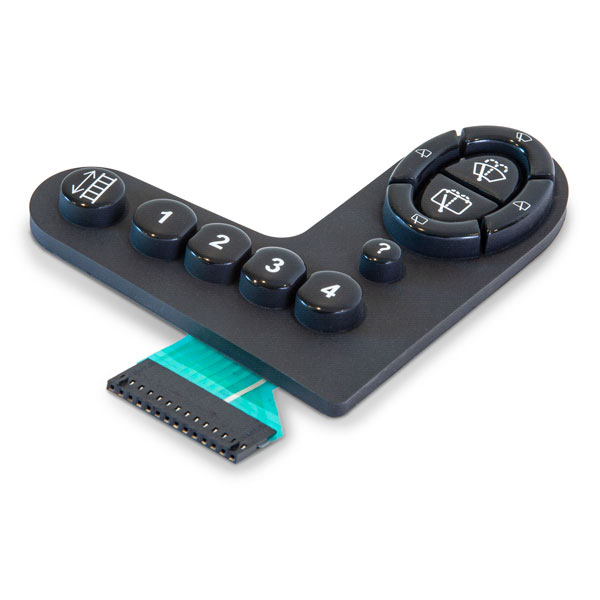The Role of Membrane Switches in Enhancing Device Functionality
The Role of Membrane Switches in Enhancing Device Functionality
Blog Article
Recognizing Membrane Changes: The Trick to Long Lasting and Reputable Controls

What Are Membrane Switches?
Membrane switches are an innovative remedy in the realm of interface innovation, incorporating capability and design perfectly. These gadgets work as a user interface in between customers and digital systems, incorporating several components into a compact format. Usually built from versatile, slim layers of products, membrane layer buttons are made to reply to touch, making it possible for customers to interact with equipment and digital tools properly.
The key components of a membrane layer switch include a printed circuit layer, graphic overlay, and a spacer layer that prevents unintended activation. The visuals overlay can be tailored to mirror brand name identification or individual preferences, enhancing appearances while ensuring use. Membrane layer buttons are typically utilized in various applications, consisting of medical devices, customer electronic devices, and industrial equipment, owing to their resilience and resistance to environmental variables such as wetness and dust.
One of the vital benefits of membrane buttons is their capability to endure wear and tear, making them ideal for high-traffic settings. Furthermore, they are lightweight and call for very little room, permitting ingenious layouts in product development. On the whole, membrane switches over represent a reliable and sensible choice for contemporary digital user interfaces, weding technology with user-centric design concepts.
How Membrane Layer Switches Job
The operation of membrane layer switches rest on a simple yet efficient mechanism that equates customer input into digital signals. These switches contain multiple layers, normally including a graphic overlay, a spacer layer, and a circuit layer. When a customer presses the switch, the top layer flaws, allowing a conductive aspect in the circuit layer to make call with a matching conductive pad on the bottom of the graphic overlay. This get in touch with shuts the circuit and sends an electronic signal to the gadget, showing that the button has been triggered.
The layout of membrane switches can vary, however they usually incorporate domes or tactile aspects to provide feedback to the user, improving the general experience - membrane switch. The products made use of in membrane layer buttons, such as polyester or polycarbonate, add to their resilience and resistance to environmental aspects, consisting of wetness and dirt. In addition, the published circuits are typically enveloped, which protects them from wear and tear over time.
Advantages of Membrane Layer Buttons

Additionally, membrane switches are understood for their longevity. Created from robust materials, they are resistant to dust, moisture, and physical wear, which considerably prolongs their life expectancy compared to standard mechanical buttons. This toughness makes them specifically ideal for high-traffic settings and applications calling for long life.
An additional substantial advantage is the simplicity of cleaning and maintenance. The smooth surface of membrane switches over decreases dirt buildup and is usually unsusceptible spills, making them excellent for setups that call for regular sanitization.
Additionally, membrane switches offer a structured account, causing a thinner style that can be integrated into numerous gadgets without adding bulk. This feature not just improves the aesthetic appeal yet additionally adds to an extra ergonomic item style.
Applications of Membrane Buttons
Functional and easy to use, membrane layer switches locate applications throughout a wide variety of sectors, including clinical devices, consumer electronic devices, and industrial equipment. In the clinical field, these buttons are essential to devices such as analysis equipment, person tracking systems, and mixture pumps, where dependability and ease of cleansing are vital. Their ability to keep and withstand severe environments functionality makes them perfect for such applications.

In customer electronics, membrane buttons are used in products like microwaves, cleaning machines, and push-button controls - membrane switch. Their streamlined design enables instinctive user interfaces, improving the total user experience while supplying durability and resistance to tear and use
Commercial equipment also profits from membrane layer buttons, particularly in control panels for machinery and automation systems. These switches use defense versus dust and moisture, making sure regular performance in difficult atmospheres. In addition, their personalized features allow producers to tailor them to certain functional demands, boosting performance and capability.
Choosing the Right Membrane Layer Switch Over
When selecting a membrane layer button, it is vital to take into consideration numerous variables that affect efficiency and suitability for particular applications. The primary factors to consider consist of ecological conditions, tactile comments, durability, and design requirements.
First, analyze the operating atmosphere; switches exposed to dampness, chemicals, or severe temperatures require details products to make sure longevity and functionality. Next off, assess the need for responsive comments. Depending on customer communication, some applications may take advantage of a tactile response to click this link validate activation, while others may like a non-tactile layout for aesthetic reasons.
Longevity is one more crucial factor; membrane layer switches must be developed to withstand regular usage, impacts, and abrasion. Guarantee the selected button can endure the anticipated lifecycle, particularly in high-usage scenarios.

Final Thought
In final thought, membrane layer switches serve as crucial components in the style of trusted and resilient control systems across numerous sectors. The flexibility of membrane switches over permits for tailored remedies that meet particular functional demands, enhancing their significance in modern technology.
Membrane layer changes stand for a crucial element of contemporary user interface layout, mixing capability with resilience in various applications.Membrane switches are a sophisticated service in the realm of individual interface innovation, integrating performance and style effortlessly. Commonly created from adaptable, slim layers of products, membrane layer buttons are created to react to touch, allowing individuals to engage with machinery and electronic devices effectively.
The design of membrane buttons can try this website differ, however they commonly integrate domes or tactile elements to provide feedback to the customer, boosting the general experience.In verdict, membrane layer switches over serve as essential components in the layout of sturdy and trusted control systems across various sectors.
Report this page